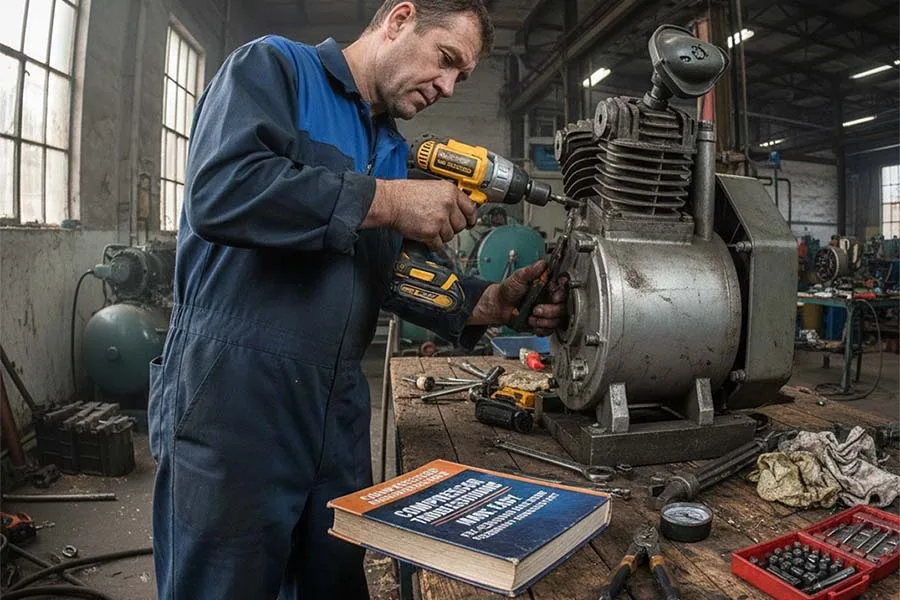Introduction: Why Compressor Troubleshooting Matters
Compressors are the heartbeat of countless industrial operations—from powering pneumatic tools to driving refrigeration systems. When they fail, productivity stalls, costs rise, and safety risks escalate. Knowing how to troubleshoot common compressor problems isn’t just a technical skill—it’s a strategic advantage.
Whether you’re a seasoned technician or a hands-on DIYer, mastering compressor diagnostics can save hours of downtime and thousands in repairs. This guide walks you through the most frequent issues, how to fix them, and how to prevent them from recurring.
Step-by-Step Guide: How to Troubleshoot Common Compressor Problems
1. Identify the Symptoms
Start by observing the compressor’s behavior:
- Is it failing to start?
- Running but not building pressure?
- Overheating or making unusual noises?
Document everything. These clues guide your diagnosis.
2. Check the Power Supply
- Inspect the power cord, plug, and outlet.
- Use a multimeter to verify voltage.
- Reset breakers or replace blown fuses.
Tip: Low voltage can mimic mechanical failure.
3. Inspect the Air Filter
- Remove and examine the intake filter.
- Clean or replace if clogged.
- A dirty filter restricts airflow and strains the motor.
4. Examine Pressure Settings
- Verify cut-in and cut-out pressure settings.
- Adjust using the pressure switch if needed.
- Incorrect settings can cause short cycling or failure to start.
5. Check for Air Leaks
- Spray soapy water on fittings, hoses, and tank seams.
- Look for bubbles indicating leaks.
- Tighten or replace faulty components.
6. Inspect Valves and Seals
- Check the intake and exhaust valves for wear or carbon buildup.
- Replace damaged seals or gaskets.
- Faulty valves reduce compression efficiency.
7. Monitor Temperature and Lubrication
- Ensure proper oil levels (for oil-lubricated models).
- Clean cooling fins and ensure adequate ventilation.
- Overheating often stems from poor lubrication or airflow.
Common Mistakes to Avoid
- Skipping the basics: Always start with power and airflow checks.
- Over-tightening fittings: This can crack components and worsen leaks.
- Ignoring maintenance logs: Past issues often repeat—track everything.
- Using the wrong oil: Can damage internal components and void warranties.
- Neglecting safety gear: Eye protection and gloves are non-negotiable.
Troubleshooting Scenarios: What to Do When Things Go Wrong
| Problem | Likely Cause | Quick Fix |
|---|---|---|
| Compressor won’t start | Power issue, pressure switch fault | Check voltage, reset switch |
| Runs but no pressure | Valve failure, air leak | Inspect valves, test for leaks |
| Overheating | Poor ventilation, low oil | Clean vents, refill oil |
| Excessive noise | Loose parts, worn bearings | Tighten bolts, inspect motor |
| Frequent cycling | Incorrect pressure settings | Adjust cut-in/cut-out levels |
Safety Warnings and Best Practices
- Always disconnect power before inspecting internal components.
- Release tank pressure before servicing.
- Use manufacturer-approved parts and lubricants.
- Never bypass safety switches or pressure relief valves.
- Keep a fire extinguisher nearby in case of electrical faults.
Compressor Troubleshooting Made Easy FAQ
Interesting Fact
The first air compressor was patented in 1799 by George Medhurst to power mining tools—laying the groundwork for modern pneumatic systems.
Lesser-Known Fact
Many compressors have a hidden unloader valve that releases pressure from the piston head during startup. If this fails, the motor may struggle to start or trip breakers.
Further Read
- Sullair LS Series Rotary Screw Compressor Review
- Sullair 185 Portable Air Compressor Review – Mobile and Durable
- Sullair OFS Series Review – Oil-Free Compressors for Pharma, Food & Electronics
- Quincy QGS Series Review: Rotary Screw Compressors
- Quincy QR-25 Review: Heavy-Duty Reciprocating Compressor
- Quincy QGS Series Review: Quiet Rotary Screw Compressors
- Kaeser CSD Series Review: High-Efficiency Rotary Screw Compressors
- Kaeser M Series Review
- Kaeser Kompressoren SM Series Review
- Atlas Copco LZ Series Review
- Atlas Copco GX Series Review: Compact Power for Small Workshops
- Atlas Copco GA VSD+ Review: The Compressor That Changed the Game
- Ingersoll Rand 2475 Review: Heavy-Duty Reciprocating Air Compressor
- Ingersoll Rand UP6 Series Review: Compact Rotary Screw Compressor
- Ingersoll Rand R-Series Review
- How to Troubleshoot Common Compressor Problems
- How to Improve Energy Efficiency of Your Compressor
- Portable vs Stationary Compressor: Which One Should You Buy?
- Top 10 Mistakes When Buying a Compressor (and How to Avoid Them)
- Industrial Air Compressor Buying Guide
Conclusion: Ready to Fix Your Compressor?
Troubleshooting compressors isn’t just about fixing problems—it’s about building confidence, reducing downtime, and mastering your tools. Follow these steps, stay safe, and keep your equipment running like new.
Have you solved a tricky compressor issue recently? Share your experience in the comments below. If this guide helped, pass it on—your fellow technicians will thank you.
Like, comment, and share this article to support the Industrial Tools learning hub.





